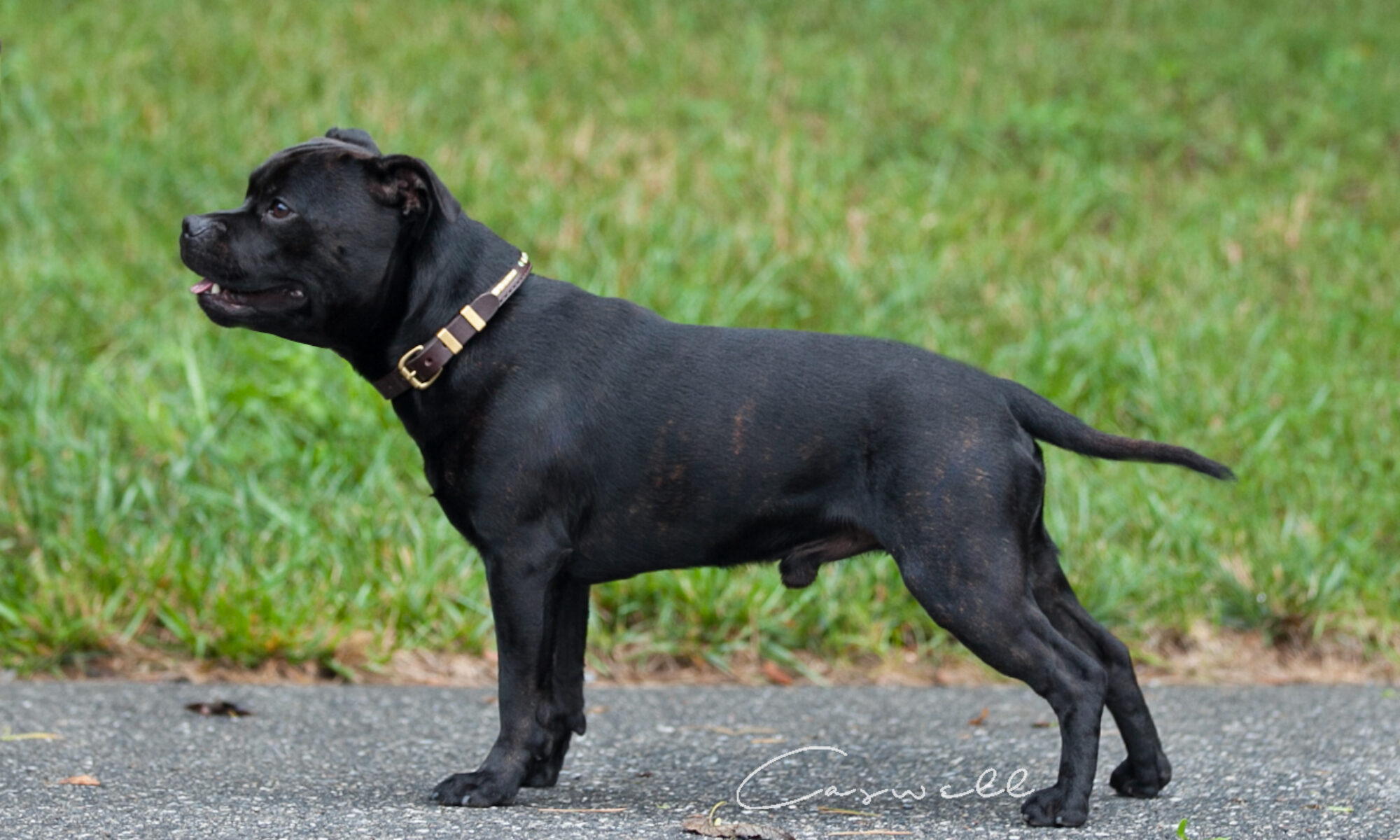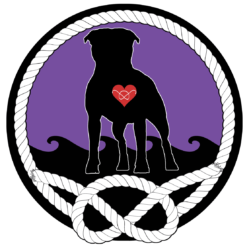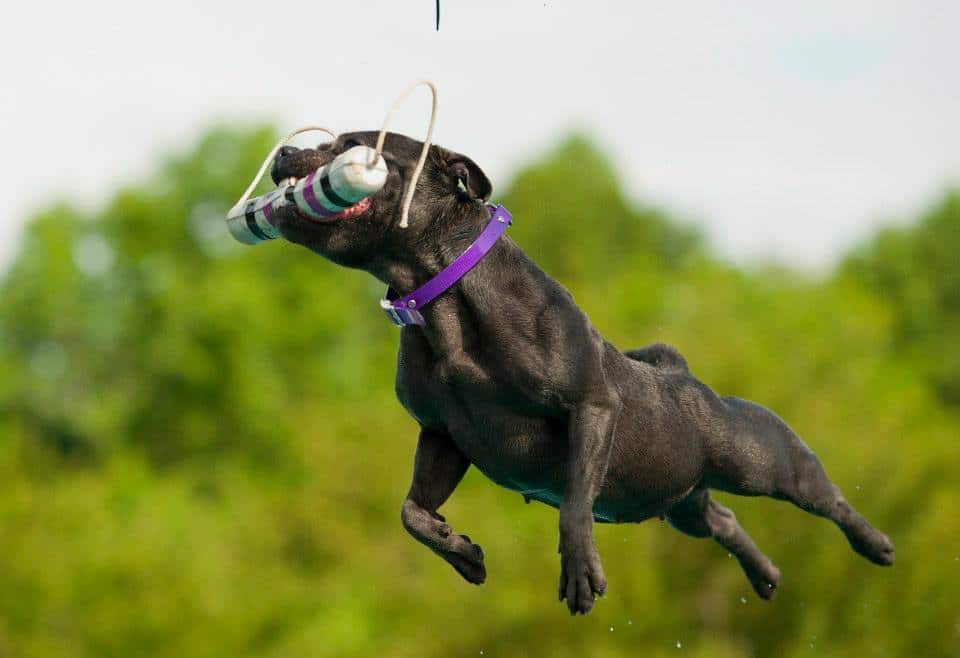
WHY ARE PLAY AND EXERCISE IMPORTANT?
Play with owners and with other friendly dogs, not only provides a dog with some of its exercise requirements, but also helps to meet social needs. Insufficient exercise (resulting in boredom) and social attention can contribute to problem behaviors including chewing, digging, garbage raiding, hyperactivity, unruliness, excitability, attention-getting behaviors, and even some forms of barking. It is especially important to ensure that a dog’s need for exercise has been met prior to leaving the dog alone at home and prior to lengthy crating or confinement sessions. Staffords do need exercise to be happy, healthy and to stay out of trouble. They can gain weight easily if not properly exercised. Some people think they need to cut back on food to maintain weight, but in reality upping the exercise, and ensuring quality exercise is a better way. Staffords should never be kept overweight! They need to be trim, fit and active.

A Tired Dog is a Good Dog
Playing with your pet is an enjoyable activity for both of you. Not only does the puppy get exercise, but also positive interactions take place. Taking your dog for a walk is a good basic way to accomplish a limited amount of exercise. Do acclimate your puppy early on (as early as 8 weeks) to a flat nylon or leather buckle collar and a lightweight leash. Practice your walking skills in your own yard first. Put your puppy on leash, and with your voice and some food treats, or perhaps a toy reward as a lure, encourage it to follow you. Reward the puppy for following you with warm praise and food treats. Keep initial walks short. You don’t need a leash if you are in a protected area with no strange dogs around. This method works well with older dogs that are hesitant about walking on a leash. Your puppy does need lots of socialization no matter how young he is so take him to safe areas to socialize. Just remember that giving your dog only a walk will not fulfill a puppies’ nor an adult dog’s daily exercise and play requirements. Dogs can benefit from some weekly playtime with other canines so they remain friendly to their own species but its not always needed. Use interactive toys, games and puzzles to stimulate your dogs mind. When a dog is engaged in mind activities it often can tire them out more than physical activities can. In fact, too much exercise can raise the tolerance and some dogs become activity junkies. A good way to find this safe play environment is to enroll your puppy or dog in a training class that provides supervised play for its enrollees. Just keep in mind that Staffords are NOT dog park dogs and as they mature, they may not get along with other dogs. Remain aware of your dog in every situation. Be aware of your dogs behaviors and body language and avoid unsafe situations. Some Staffords are fine with other dogs, but many are not. Just know YOUR dog and his/her behaviors. How you and your Stafford act in public speaks for the entire breed. We are more scrutinized than many other owners of other breeds so please be aware of this and act accordingly.
WHAT ARE GOOD WAYS TO PLAY WITH AND EXERCISE MY PUPPY OR DOG?
Selecting an appropriate amount and type of play and exercise can depend firstly on the type of dog and secondly, on the age of your dog. Puppies and even adult dogs from breeds that have been bred for their stamina or to do “work” often have higher exercise requirements. In general for purebred dogs, consider their traditional work (what the breed was originally bred for) when deciding the type and amount of play to provide. For example, the retrieving breeds do best with lengthy games of fetch or swimming while the sledding breeds might prefer pulling carts or jogging with an active owner. As Staffords are a ‘foremost all purpose’ breed they can and will want to do just about any exercise you want. Some types of exercise many Stafford owners do with their charges are Flirt Pole, “A” Frame, Spring Pull, Frisbee, Carpet and Slat Mills, Weight Pull, Fetch, Swimming (with float coats on of course) and just about any other type of activity they enjoy. Staffords excel at Agility, Obedience, Rally, Nose Work, Tracking, Barn Hunt and Conformation. While some adult dogs may still be ready for more after a 5 mile jog and a game of fetch, others may be tired and satisfied after a short walk around the block. Keep in mind that all dogs need to acclimate themselves slowly to any type of exercise you choose to enjoy with your charge. Do not let them get over heated or dehydrated. Always err on the side of caution in warmer months.
One thing is for certain however; each animal, young or old, should have at least two daily exercise sessions per day; ranging from 15 minutes for a puppy or senior citizen, up to 60 minutes for a healthy adult dog. As a general rule of thumb, any dog under 18 months of age, should not be asked to do rigorous heavy exercise, such as jogging, as it may cause skeletal problems since your dog is still growing. Please consult your veterinarian or your dogs breeder before you begin a rigorous exercise program for any dog, especially an “out of shape” adult. We follow the exercise guidelines in the Puppy Culture booklet.
HOW MUCH EXERCISE AND PLAY IS APPROPRIATE ?
When you are out or busy at home with other activities and responsibilities, it would be ideal for your dog to be relaxed and sleeping, but this will not always be the case. Exploring the environment, stealing food items, raiding garbage cans, chewing or digging, are just a few of the ways that dogs will find to keep themselves occupied. If you must leave your dog alone, first provide plenty of exercise so your pet is tired and more likely to sleep. Next, make sure to confine your pet to a safe, dog-proofed indoor area or a crate. Dogs left outdoors for long periods often develop destructive habits (redesigning your landscape) or bark so much the neighbors complain. Lastly before leaving your dog alone, provide sufficient novel toys and distractions to keep your dog occupied. We like to provide plenty of Goughnut toys and treat balls for our Staffords. Stuffed Kongs are also a great choice. Provide several Kongs, laced with food such as cheese, peanut butter, frozen yogurt, frozen baby foods, hot dogs, or bits of chicken, steak or fish. These will give your dog something to do other than bark, chew the wrong items or try to escape. Our Staffords will chew thru most Kongs, even the heavy duty black ones so we cant use them, but some Staffords are fine with them. Self-feeding toys such a Buster Cubes or Activity Balls are also good choices for those who feed kibble – we suggest dried chicken gizzard, hearts and livers. Just be sure to adjust your dogs meal according to how many ‘snacks’ he/she gets during the day. Whatever your dog prefers, give it to him just before you leave and when you return, take the items away. This keeps the home-alone items interesting and stimulating.
Teaching the dog to “drop” or “give” on command can help to ensure that you remain in control of object play sessions such as fetch and tug -of -war. Although games like chase are good exercise, they can often result in wild exuberant play that gets out of control. A good rule of thumb is to only play these games, if you are the one to initiate the game, and are capable of stopping the game immediately should it get out of control. Also teach the command to “settle” so you have control when things get too heated. Many dogs can be taught to play “hide and seek” without becoming too excited (the human hides with a treat or a toy to reward the dog for finding them). Other dogs like to “search” for their toys or treats. Staffords can easily learn many fun tricks and games. They are easy to train and enjoy both the learning and the human interaction. It is important that if you have young children (12 years and under) in your family that all interaction, including games, be supervised 100% of the time by a watchful adult.
REMINDERS
Always pick up any solid elimination immediately.
Dogs do not make moral decisions, so therefore all mistakes they make are YOUR fault in some way. Take responsibility for your dogs!
Practice calling your dog to you often and rewarding him with food treats. A good recall can save your dog’s life.
Watch for signs of trouble (via body language), stiff walk, stiff high tail that is wagging slowly, hackles up, growling, showing of teeth (snarling). At the first sign of trouble, call your dog away in a happy tone of voice. You have a Stafford and it is a part of the breed to sometimes exhibit a bit of fire. It is YOUR responsibility to keep that fire under control and make your dog immediately recover.
You are liable for any damages your dog may do to another. If your dog seems to get in more and more scuffles, consider more training and interactive play AND getting R+ professional help. Again – always take responsibility for your Stafford!
If a fight breaks out, try dousing with water or a carbonated beverage, pulling up and back on hind legs (as someone is pulling up and down to the other dog), throwing a blanket or coat over them. Do not attempt to reach in between the dogs as you could be bitten and seriously hurt. If alone tie one dog off to a sturdy post or fence. Then lift the other dog up and in – or out – to force him to let go – not something an amateur should try. There are some Staffords who live harmoniously for years with others and one day it all ends and will forever after need to be separated from that dog. It happens. Just be prepared to deal with it. Accept it and don’t make excuses. You have a gladiator breed who my not like other animals but must always get along with humans
PLEASE BE AWARE OVERHEATING CAN BE A REAL CONCERN FOR A STAFFORD. IN HUMID WEATHER TAKE ALL PRECAUTIONS NOT TO ALLOW YOUR STAFFORD TO OVER HEAT. EXERCISE EARLY IN THE MORNINGS OR LATE IN THE EVENINGS. KEEP PLENTY OF FRESH COOL WATER ON HAND. INVEST IN A COOL COAT. CARRY A SPRAY BOTTLE AND ALCOHOL PREP PADS WHEN HIKING.





